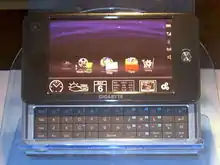Mobile Internet device
A mobile Internet device (MID) is a multimedia capable mobile device providing wireless Internet access.[1][2][3] They are designed to provide entertainment, information and location-based services for personal or business use. They allow 2-way communication and real-time sharing. They have been described as filling a niche between smartphones and tablet computers.[4]

As all the features of MID started becoming available on smartphones and tablets, the term is now mostly used to refer to both low-end as well as high-end tablets.[5]
Archos Internet tablets
The form factor of mobile Internet tablets from Archos is very similar to the Lenovo image on the right. The class has included multiple operating systems: Windows CE, Windows 7 and Android. The Android tablet uses an ARM Cortex CPU and a touchscreen.

Intel announced a prototype MID at the Intel Developer Forum in Spring 2007 in Beijing. A MID development kit by Sophia Systems using Intel Centrino Atom was announced in April 2008.[6]
Intel MID platforms are based on an Intel processor and chipset which consume less power than most of the x86 derivatives. A few platforms have been announced as listed below:
McCaslin platform (2007)
Intel's first generation MID platform (codenamed McCaslin) contains a 90 nm Intel A100/A110 processor (codenamed Stealey) which runs at 600–800 MHz.
| Centrino | McCaslin platform |
|---|---|
| Mobile chipset | an Intel 945GU Express MCH northbridge (codenamed Little River) with integrated GMA 950 graphics and an ICH7-U southbridge |
| Mobile processor | a 90 nm Intel A100/A110 processor (codenamed Stealey) |
| Wireless network | a wireless radio |
Menlow platform (2008)
On 2 March 2008, Intel introduced the Intel Atom processor brand[7] for a new family of low-power processor platforms. The components have thin, small designs and work together to "enable the best mobile computing and Internet experience" on mobile and low-power devices.
Intel's second generation MID platform (codenamed Menlow) contains a 45 nm Intel Atom processor (codenamed Silverthorne) which can run up to 2.0 GHz and a System Controller Hub (codenamed Poulsbo) which includes Intel HD Audio (codenamed Azalia). This platform was initially branded as Centrino Atom but such practice was discontinued in Q3 2008.
| Centrino | Menlow platform |
|---|---|
| Mobile chipset | an Intel SCH (codenamed Poulsbo) with integrated GMA 500 graphics (PowerVR SGX 535 based) |
| Mobile processor | a 45 nm Intel Atom processor (codenamed Silverthorne) |
| Wireless network | a wireless radio |
Moorestown platform (2010)
Intel's third generation MID/smartphone platform (codenamed Moorestown) contains a 45 nm Intel Atom processor (codenamed Lincroft ) and a separate 65 nm Platform Controller Hub (codenamed Langwell). Since the memory controller and graphics controller are all now integrated into the processor, the northbridge has been removed and the processor communicates directly with the southbridge via the DMI bus interface.
| Atom | Moorestown platform |
|---|---|
| Mobile chipset | a 65 nm Intel PCH (codenamed Langwell) and an MSIC (codenamed Briertown) |
| Mobile processor | a 45 nm Intel Atom processor (codenamed Lincroft) with integrated GMA 600 graphics (PowerVR SGX 535 based) |
| Wireless network | a wireless radio (codenamed Evans Peak)[8] |
Medfield platform (2012)
Intel's fourth generation MID/smartphone platform (codenamed Medfield) contains their first complete Intel Atom SoC (codenamed Penwell), produced on 32 nm.
| Atom | Medfield platform |
|---|---|
| Mobile processor | a 32 nm Intel Atom SoC (codenamed Penwell) with integrated CPU (codenamed Saltwell) and graphics (PowerVR SGX 540 based) |
| Wireless network | a wireless radio |
Clover Trail+ platform (2012)
Intel's MID/smartphone platform (codenamed Clover Trail+) based on its Clover Trail tablet platform. It contains a 32 nm Intel Atom SoC (codenamed Cloverview).
| Atom | Clover Trail+ platform |
|---|---|
| Mobile processor | a 32 nm Intel Atom SoC (codenamed Cloverview) with integrated CPU (codenamed Saltwell) and graphics (PowerVR SGX 545 based) |
| Wireless network | a wireless radio |
Merrifield platform (2013)
Intel's fifth generation MID/smartphone platform (codenamed Merrifield ) contains a 22 nm Intel Atom SoC (codenamed Tangier).
| Atom | Merrifield platform |
|---|---|
| Mobile processor | an Intel Atom SoC (codenamed Tangier) with integrated CPU (codenamed Silvermont) and graphics (PowerVR G6400[9]) |
| Wireless network | a wireless radio |
Moorefield platform (2014)
Intel's sixth generation MID/smartphone platform (codenamed Moorefield) contains a 22 nm Intel Atom SoC (codenamed Anniedale).
| Atom | Moorefield platform |
|---|---|
| Mobile processor | an Intel Atom SoC (codenamed Anniedale) with integrated CPU (codenamed Airmont) and graphics (PowerVR G6430[10]) |
| Wireless network | a wireless radio |
Morganfield platform
Intel's seventh generation MID/smartphone platform (codenamed Morganfield) contains a 14 nm Intel Atom SoC (codenamed Broxton).
| Atom | Morganfield platform |
|---|---|
| Mobile processor | an Intel Atom SoC (codenamed Broxton) with integrated CPU (codenamed Goldmont) and graphics (Gen 9) |
| Wireless network | a wireless radio |
Operating system
Intel announced collaboration with Ubuntu to create Ubuntu for mobile internet devices distribution, known as Ubuntu Mobile. Ubuntu's website said the new distribution "will provide a rich Internet experience for users of Intel’s 2008 Mobile Internet Device (MID) platform."[11]
See also
References
- Forward Concepts (June 2008), Mobile Internet Devices (MID) & Chip Market Opportunities, archived from the original on 2008-10-13, retrieved 2008-10-27
- "Mobile Internet Device (MID)", www.arm.com, archived from the original on 2008-10-30, retrieved 2008-10-27
- "Wireless Handset Solutions: Mobile Internet Device", focus.ti.com, retrieved 2008-10-27
- What is a Mobile Internet Device?, November 2008, retrieved 2008-11-02
- How MID Tablets Work?, November 2013
- MID dev kit sports Centrino Atom chipset, archived from the original on 2012-12-06
- Intel Announces Intel Atom Brand for New Family of Low-Power Processors
- Moorsetown: Intel's Next Generation Platform for MIDs and Smartphones (PDF)
- Shimpi, Anand Lal. "Intel Talks Atom Z3460/Z3480 (Merrifield), Z3560/Z3580 (Moorefield) and LTE at MWC 2014". www.anandtech.com. Retrieved 4 May 2023.
- Shimpi, Anand Lal. "Intel Talks Atom Z3460/Z3480 (Merrifield), Z3560/Z3580 (Moorefield) and LTE at MWC 2014". www.anandtech.com. Retrieved 4 May 2023.
- Canonical Announces Details of Ubuntu for Mobile Internet Devices, 2007-06-07, archived from the original on 2007-06-09, retrieved 2007-06-12